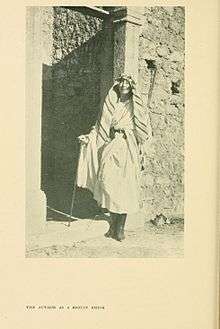Rosita Forbes

Rosita Forbes, née Joan Rosita Torr (16 January 1890 – 30 June 1967) was an English travel writer and explorer. In 1920-21 she was the first European woman to visit the Kufra Oasis in Libya (together with the Egyptian explorer Ahmed Hassanein), in a period when this was closed to westerners.[1]
Early life
Joan Rosita Torr was born at Riseholme Hall, near Lincoln, England, the daughter of Herbert James Torr and Rosita Graham Torr. Her father was a member of Parliament.[2]
Career
During World War I she drove an ambulance in France for two years. From 1917 to 1918, she traveled in Asia with another unhappy military wife, Armorel Meinertzhagen,[3] visiting thirty countries. After the war, she and Meinertzhagen traveled in North Africa, "with little money but much ingenuity."[4] The result was her first book, Unconducted Wanderers (1919). The next year, she pretended to be an Arab woman named "Sitt Khadija" to visit the Kufra Oasis in 1921, the first European woman (and only the second European) known to see that location. The way she portrayed her travel guide, Hassanein Bey, as a minor part of the journey was criticized by her book's reviewers and his colleagues, who pointed out that he was an Oxford-educated diplomat.[5]
Rosita Forbes found an audience as a daring and witty travel writer and lecturer between the wars, and as a novelist; but her reputation was somewhat tarnished in the 1930s by her description of walking through a flower garden with Adolf Hitler, and her meetings with Benito Mussolini.[6] She published a book of interviews in 1940, These Men I Knew, insisting that she was only reporting their politics, not endorsing them; she also lectured in support of the British war effort in Canada and the United States. Soon, the McGraths went to live in the Bahamas to avoid further controversy.[4]
Forbes was made a fellow of the Royal Geographical Society, and received medals from the Royal Antwerp Geographical Society and the French Geographical Society, and an award in 1924 from the Royal Society of Arts.[6] She also made an early travel film, From Red Sea to Blue Nile, and two of her novels became silent films (Fighting Love (1927) and The White Sheik (1928), based on her novels If the Gods Laugh and Account Rendered, respectively).[2] Her 1924 biography, The Sultan of the Mountains: The Life of Story of Raisuli, was loosely adapted for the screen in 1972 by John Milius as The Wind and the Lion.[7]
Personal life
Joan Rosita Torr married Colonel Robert Foster Forbes in 1911. They divorced after she left him in 1917, selling her wedding ring and sailing for South Africa. She married again in 1921, to Arthur Thomas McGrath. She was widowed in 1962, and she died in 1967, at home in Warwick, Bermuda, aged 77 years.[1]
Works by Rosita Forbes
- Unconducted wanderers, 1919
- The secret of the Sahara: Kufara, 1921
- The sultan of the mountains; the life story of Raisuli, 1924
- From Red sea to Blue Nile; Abyssinian adventure, 1925 (also published under the title From Red Sea to Blue Nile; a thousand miles of Ethiopia?)
- Adventure, 1928
- Conflict; Angora to Afghanistan, 1931
- Eight republics in search of a future; evolution & revolution in South America, 1932
- Women called wild, 1935
- Forbidden road--Kabul to Samarkand, 1937
- These are real people, 1937
- A unicorn in the Bahamas, 1939
- India of the princes, 1939
- These men I knew, 1940
- Gypsy in the sun, 1944
- Appointment with destiny, 1946
- Henry Morgan, pirate, 1946
- Sir Henry Morgan, pirate & pioneer, 1948
- Islands in the sun, 1949
References
- 1 2 Dorothy Middleton, "(Joan) Rosita Forbes" in Oxford Dictionary of National Biography (Oxford University Press 2004).
- ↑ Brian Garfield, The Meinertzhagen Mystery: The Life and Legend of a Colossal Fraud (Potomac Books 2007): 74. ISBN 9781597970419
- 1 2 Kamila Shamsie, "Rosita Forbes: The Travel Writer They Couldn't Tame" Telegraph (22 April 2014).
- ↑ Arita Baasjens, Desert Songs: A Woman Explorer in Egypt and Sudan (American University of Cairo Press 2008): 44-45. ISBN
- 1 2 H. M. Teo, "Gypsy in the Sun: The Transnational Life of Rosita Forbes" in Desley Deacon, Penny Russell, and Angela Woollacott, eds., Transnational Lives: Biographies of Global Modernity, 1700-Present (Palgrave Macmillan 2010): 273-285. ISBN 9781349315789
- ↑ "The Wind, the Lion, and Rosita Forbes" Tangier American Legation Institute for Moroccan Studies (2 October 2012).
External links
- The National Portrait Gallery has several images of Rosita Forbes, including one political cartoon.
- Margaret Bald, ed., From The Sahara to Samarkand: Selected Travel Writings of Rosita Forbes, 1919-1937 (Axios Press 2010). ISBN 9781604190304
- Works by or about Rosita Forbes at Internet Archive